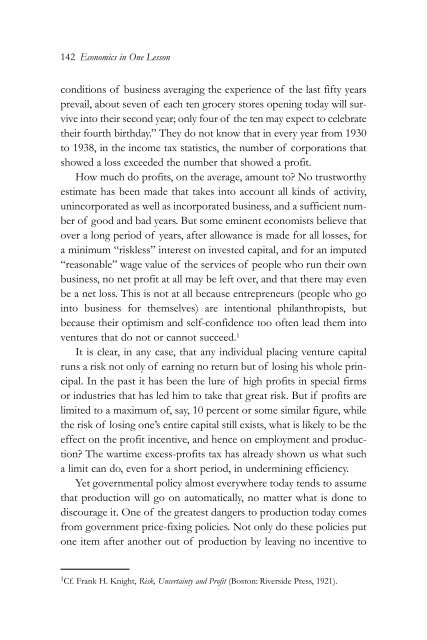1gDdM7w
1gDdM7w
1gDdM7w
- No tags were found...
You also want an ePaper? Increase the reach of your titles
YUMPU automatically turns print PDFs into web optimized ePapers that Google loves.
142 Economics in One Lessonconditions of business averaging the experience of the last fifty yearsprevail, about seven of each ten grocery stores opening today will surviveinto their second year; only four of the ten may expect to celebratetheir fourth birthday.” They do not know that in every year from 1930to 1938, in the income tax statistics, the number of corporations thatshowed a loss exceeded the number that showed a profit.How much do profits, on the average, amount to? No trustworthyestimate has been made that takes into account all kinds of activity,unincorporated as well as incorporated business, and a sufficient numberof good and bad years. But some eminent economists believe thatover a long period of years, after allowance is made for all losses, fora minimum “riskless” interest on invested capital, and for an imputed“reasonable” wage value of the services of people who run their ownbusiness, no net profit at all may be left over, and that there may evenbe a net loss. This is not at all because entrepreneurs (people who gointo business for themselves) are intentional philanthropists, butbecause their optimism and self-confidence too often lead them intoventures that do not or cannot succeed. 1It is clear, in any case, that any individual placing venture capitalruns a risk not only of earning no return but of losing his whole principal.In the past it has been the lure of high profits in special firmsor industries that has led him to take that great risk. But if profits arelimited to a maximum of, say, 10 percent or some similar figure, whilethe risk of losing one’s entire capital still exists, what is likely to be theeffect on the profit incentive, and hence on employment and production?The wartime excess-profits tax has already shown us what sucha limit can do, even for a short period, in undermining efficiency.Yet governmental policy almost everywhere today tends to assumethat production will go on automatically, no matter what is done todiscourage it. One of the greatest dangers to production today comesfrom government price-fixing policies. Not only do these policies putone item after another out of production by leaving no incentive to1 Cf. Frank H. Knight, Risk, Uncertainty and Profit (Boston: Riverside Press, 1921).


